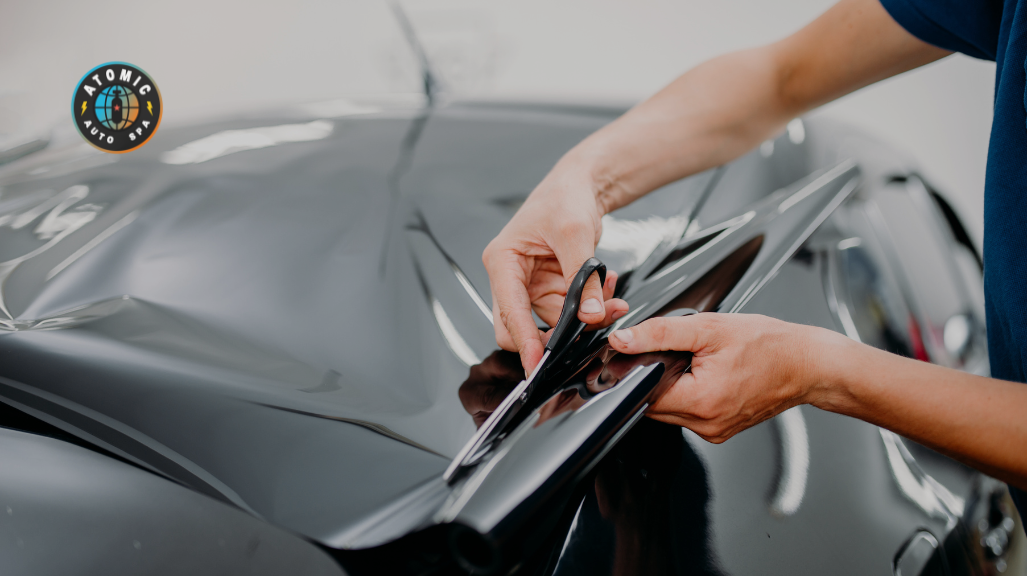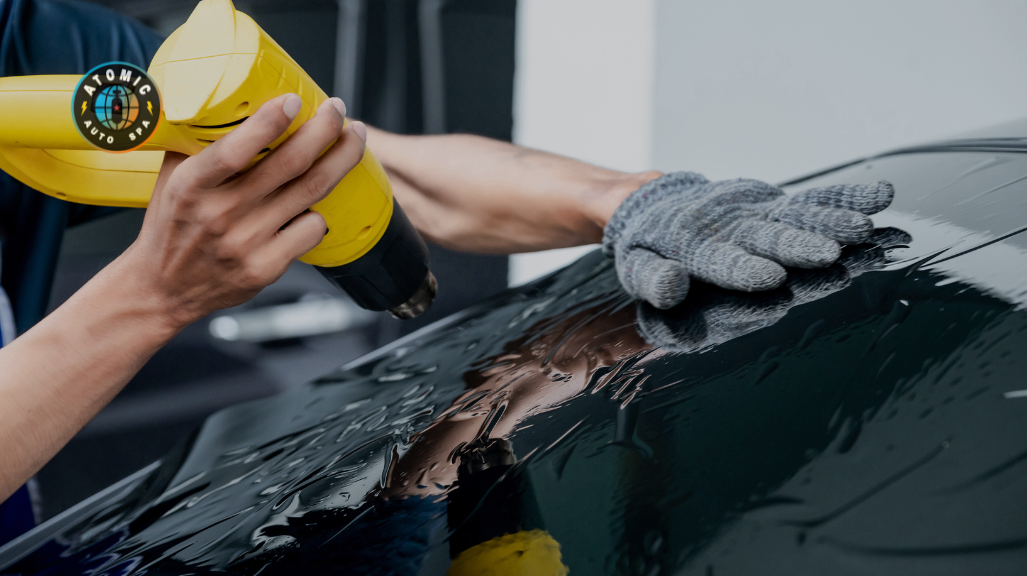Ceramic Tint vs. Metallic Tint: Which One Should You Choose for Performance and Style?
When choosing between ceramic windows and metallic tint for performance and style, a car owner should consider heat rejection properties, UV protection, and long-term durability. Ceramic tint blocks infrared light, offers superior UV protection, and maintains optical clarity without interfering with electronic devices. In contrast, metallic window tints provide strong reflective efficiency and are often a more budget-friendly choice, but they may compromise radio reception and cell phone signal quality.
At Atomic Auto Spa, we specialize in window tinting needs, offering cutting-edge technology to vehicle owners seeking exceptional heat rejection properties and superior performance.
This guide will help you decide between ceramic vs. metallic tint to enjoy optimal performance without compromising visibility.
Key Takeaways
Ceramic window tint offers superior benefits in blocking infrared light, ensuring higher heat rejection properties and enhanced visibility.
Metallic window tints provide cost-effective UV protection but can affect radio reception and compromise visibility.
Carbon tint and carbon window tints balance traditional tints and high-tech ceramic films, reducing sun exposure and heat reduction.
Unlike metalized film, ceramic window film does not interfere with electronic devices, making it the preferred option for advanced features.
Professional installation ensures that your window films last longer, maintain optical clarity, and prevent sun damage.
Understanding Window Tinting Needs
The Role of Window Tint Films in Heat Reduction
The window tinting industry has evolved, introducing advanced technology like ceramic films outperforming traditional tints in heat rejection and UV protection. Whether you're looking for dyed film, carbon film, or ceramic window film, understanding how infrared light and solar heat affect your car's interior will help you choose the best option.
How Window Tinting Helps Car Owners
Blocking heat: Reduces interior temperatures, keeping your car cool in extreme heat.
Reducing glare: Enhances visibility by reducing glare reduction issues.
Protecting against harmful UV rays: Prevents skin cancer and protects your car’s interior from sun damage.
Cutting air conditioning costs: Reducing solar heat minimizes air conditioning usage.
Ceramic Window Tint: Advanced Technology for Superior Performance
Exceptional Heat Rejection Properties of Ceramic Tint
Ceramic window tint is known for its exceptional heat rejection properties due to its blocking infrared light capabilities. It offers higher initial cost, but its superior UV protection and infrared radiation blocking make it the preferred choice for vehicle owners seeking long-term durability. Additionally, ceramic window tint takes privacy to the next level with a one-way mirror effect while maintaining visibility, and it enhances clarity and reduces glare, making it ideal for driving in bright conditions.
Key Benefits of Ceramic Window Tint
Superior UV protection: Blocks up to 99% of ultraviolet rays, preventing sun damage.
Infrared radiation blocking: Reduces heat buildup, keeping interior temperatures comfortable.
No interference with electronic devices: Unlike metallic particles, ceramic window tint ensures optimal performance for cell phones, radio reception, and GPS.
Enhanced visibility: Maintains optical clarity, ensuring a safer driving experience.
Ceramic window tinting: Offers superior durability and performance compared to other tint options, with excellent UV protection, heat rejection, and glare reduction.
Metallic Tint: Affordable Alternative with Some Trade-offs
Heat Rejection & UV Protection in Metallic Tints
While metallic window tints offer heat reduction, they also contain metallic particles that may interfere with electronic devices. They provide basic benefits at a lower cost but are not as effective as ceramic films in blocking infrared radiation. Ceramic window tints can block up to 99% of ultraviolet (UV) light, protecting the vehicle's interior and the occupants' skin from harmful rays.
Pros and Cons of Metallic Window Tints
|
Feature |
Ceramic Tint |
Metallic Tint |
|---|---|---|
|
Heat Rejection |
Exceptional – Blocks infrared light |
Moderate – Uses metalized layers |
|
UV Protection |
Superior UV protection – 99% UV rays |
Good UV protection, but lower than ceramic |
|
Signal Interference |
None – No impact on radio reception |
Yes – It may interfere with radio, GPS, & cell phones |
|
Aesthetic Appeal |
Matte finish – High-end look |
Reflective finish – Shiny appearance |
|
Durability |
Superior benefits – Lasts longer |
Fades over time, reducing efficiency |
|
Cost |
Higher initial cost – Long-term investment |
Lower cost – More budget-friendly |
Making an Informed Decision: Which Tint Should You Choose?
Choosing the right tint depends on your window tinting needs. If you’re looking for advanced features, ceramic tints are the best choice due to their superior performance in heat rejection and UV protection, as well as their ability to not interfere with electronic signals. They also offer enhanced visibility and are made from non-metallic materials, making them a premium choice despite their higher cost. However, if budget is a concern and radio reception isn’t a major factor, metallic tints provide a cost-effective alternative.
Frequently Asked Questions
-
Ceramic window tint provides the best heat rejection due to its ability to block infrared radiation and solar heat. It keeps interior temperatures lower and reduces air conditioning usage, making it the top choice for superior performance.
-
Yes, metallic window tints contain metallic particles that can disrupt radio reception, cell phones, and GPS signals. If maintaining electronic connectivity is a priority, ceramic window film is a better option.
-
Ceramic window tint lasts longer than metallic tint, as it does not fade or degrade over time. Metallic tints may require more frequent replacements due to their tendency to fade and oxidize.
-
Yes, ceramic window tint blocks up to 99% of ultraviolet rays, offering superior UV protection and reducing sun exposure risks, such as skin cancer and sun damage to your car’s interior.
-
The metallic tint is generally more budget-friendly, but ceramic tint offers long-term savings due to its superior benefits, including heat rejection properties, UV protection, and durability.
Final Thoughts: Why Choose Atomic Auto Spa?
Atomic Auto Spa, we offer professional installation of ceramic window tint, carbon tint, and metallic tints, ensuring optimal performance and enhanced visibility for your window tinting needs. Our cutting-edge technology guarantees superior performance, preventing skin cancer, reducing glare, and keeping your car cool.
Ready to upgrade your tint? Contact our window tinting specialists today and experience the best in heat rejection, UV protection, and long-lasting durability!



